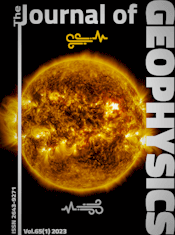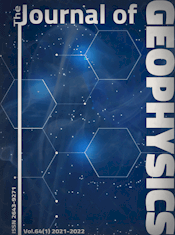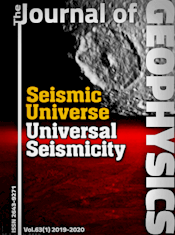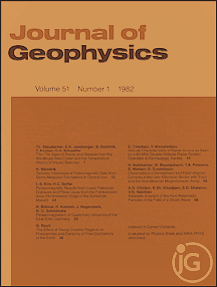Scaling relations for energy magnitudes
Article Sidebar
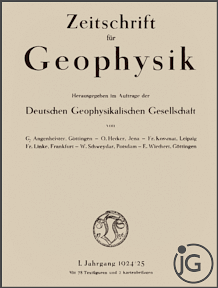
Vols. 1-18 (1924-1944), ISSN 0044-2801
Main Article Content
Abstract
Homogenizing earthquake catalogs is an effort critical to fundamentally improving seismic studies for next-generation seismology. The preparation of a homogenous earthquake catalog for a seismic region requires scaling relations to convert different magnitude types, like the mb and Ms, to a homogenous magnitude, such as the seismic moment scale, Mwg, and energy magnitude scale, Me. Several recent studies addressed the preparation of homogenized earthquake catalogs, usually involving the estimation of proxies of moment magnitude Mw from local, ML, and teleseismic (Ms and mb) magnitude estimates. Instead of the standard least squares (SLR), most of such studies used the general orthogonal regression (GOR), while some used the Chi-square regression method. Here we critically discuss GOR and Chi-square regression theory and find that both are the same for the linear case — as expected since both stem from the same mathematical concept. Thus to foster an improved understanding of seismicity and seismic hazard, we used GOR methodology and derived global scaling relations individually between body, surface, energy, and seismic moment magnitude scales. For that purpose, we have compiled 13,576 and 13,282 events for Ms from ISC and NEIC, respectively, mb magnitude data for 1,266 events from ISC, 614 events from NEIC, and Mwg magnitude values for 6,690 events from NEIC and GCMT. We have also derived MS,ISC-to-Me and MS,NEIC-to-Me conversion relations in magnitude ranges of 4.7≤MS,ISC≤8.0 and 4.5≤MS,NEIC≤8.0, respectively. Likewise, we obtained mb,ISC-to-Me and mb,NEIC-to-Me conversion relations for ranges of 5.2≤mb,ISC≤6.2 and 5.3≤mb,NEIC≤6.5. Since the number of data points was insufficient to derive the relations, we considered mb,NEIC up to M6.5. Finally, we derived an MWg-to-Me conversion relation for the 5.2≤Mw≤8.2 range of magnitudes with focal depths <70 km. Our scaling relations can be used for homogenizing earthquake catalogs and conducting seismicity and seismic hazard assessment studies with enhanced realism.
 ARK: https://n2t.net/ark:/88439/x063005
ARK: https://n2t.net/ark:/88439/x063005
Permalink: https://geophysicsjournal.com/article/304
Article Details
References
Beresnev, I.A. (2009) The reality of the scaling law of earthquake-source spectra. J. Seism. 13:433-436
Boatwright, J., Choy, G.L. (1986) Teleseismic estimates of the energy radiated by shallow earthquakes. J. Geophys. Res. 91:2095–2112
Bormann, P., Baumbach, M., Bock, M., Grosser, H., Choy, G.L., Boatwright, J. (2002) Seismic sources and source parameters. In: Bormann, P. (Ed.), in: IASPEI New Manual Seismological Observatory Practice, GeoForschungsZentrum Potsdam, Vol. 1, Chapter 3, 94 pp.
Bormann P, Liu, R., Xu., Z., Ren, K., Zhang, L., Wendt, S (2009) First application of the new IASPEI teleseismic magnitude standards to data of the China National Seismographic Network. Bull. Seism. Soc. Am. 99(3):1868-1891
Bormann, P., Saul, J. (2009) Earthquake Magnitude. Ency. Complex. Appl. Syst. Sci., 3, pp. 2473–2496
Bormann, P., Giacomo, D.D. (2010) The moment magnitude Mw and the energy magnitude Me: Common roots and differences, J. Seismol. 15:411–427
Bormann, P. (2020) Earthquake Magnitude. Encyclopedia of Solid Earth Geophysics, Encycl. Ea. Sci. Ser.
Carroll, R.J., Ruppert, D. (1996) The use and misuse of orthogonal regression estimation in linear errors-in-variables models. The Amer. Statis. 50(1):1–6
Choy, G.L., Boatwright, J. (1995) Global patterns of radiated seismic energy and apparent stress. J. Geophys. Res. 100:18205–18228
Choy, G.L., Kirby, S. (2004) Apparent stress, fault maturity and seismic hazard for normal-fault earthquakes at subduction zones. Geophys. J. Int. 159:991–1012
Castellaro, S., Mulargia, F., Kagan, Y.Y. (2006) Regression problems for magnitudes. Geophys. J. Int. 165:913-930
Das, R., Wason, H.R. (2010) Comment on "A homogenous and complete earthquake catalog for Northeast India and the adjoining region" by Yadav, R.B.S., Bormann, P., Rastogi, B.K., Das, M.C., Chopra, S., Seism. Res. Lett. 81(2):232-234
Das, R., Wason, H.R., Sharma, M.L. (2011) Global regression relations for conversion of surface wave and body wave magnitudes to moment magnitude. Natu. Haza. 59(2):801-810
Das, R., Wason, H.R., Sharma, M.L. (2012) Magnitude conversion to unified moment magnitude using orthogonal regression. Jour. Asi. Ear. Sci. 50(2):44-51
Das, R., Wason, H.R., Sharma, M.L. (2013) General Orthogonal Regression Relations between body wave and moment magnitudes, Seismol. Res. Lett. 84:219-224
Das, R., Wason, H.R., Sharma, M.L. (2014) Unbiased Estimation of Moment Magnitude from Body and Surface Wave Magnitude. Bull. Seism. Soc. Am. 104(4):1802-1811
Das, R., Wason, H.R., Gonzalez, G., Sharma, M.L., Choudhury, D., Narayan., R., Pablo, S. (2018) Earthquake Magnitude Conversion Problem. Bull. Seism. Soc. Am. 108(4):1995-2007
Das, R., Sharma, M.L., Wason, H.R., Choudhury, D., Gonzalez, G. (2019) A seismic moment magnitude scale. Bull. Seism. Soc. Am. 109(4):1542-1555
Fuller, W.A. (1987) Measurement Error Models. Wiley, New York, USA.
Giacomo, D, Parolai, D.S., Bormann, P., Grosser, H., Saul, J., Wang, R., Zschau, J. (2010) Suitability of rapid energy magnitude estimations for emergency response purposes. Geophys. J. Int. 180:361-374
Giacomo, D. (2011) Determination of the energy magnitude ME: application to rapid response purposes and insights to regional/local variabilities. University of Potsdam, Germany
Giacomo, D., Bondár, D.I., Storchak, D.A., Engdahl, E.R., Bormann, P., Harris, J. (2015) ISC-GEM: Global Instrumental Earthquake Catalogue (1900–2009): III. Recomputed Ms and mb, proxy Mw, final magnitude composition and completeness assessment. Phys. Earth Planet. In. 239:33–47
Gutenberg, B. (1945a) Amplitude of surface waves and magnitude of shallow earthquakes. Bull. Seism. Soc. Am. 35:3–12
Gutenberg, B. (1945b) Amplitudes of P, PP and S and magnitudes of shallow earthquakes. Bull. Seism. Soc. Am. 35:57-69
Gutenberg, B., Richter, C.F. (1956) Earthquake magnitude, intensity, energy, and acceleration (second paper). Bull. Seism. Soc. Am. 46(2):105–145
Hanks, T.C., Kanamori, H. (1979) A moment magnitude scale. J. Geophys. Res. 84:2348-2350
IASPEI (2013) Summary of Magnitude Working Group Recomms. on Standard Procedures for Determining Earthquake Magnitudes from Digital Data; www.iaspei.org/ commissions/CSOI/Summary_of_WG_recommendations.pdf
Kanamori, H. (1977) The energy release in great earthquakes. J. Geophys. Res. 82:2981-2987
Kendall, M.G., Stuart, A. (1979) The Advanced Theory of Statistics. Vol. 24th ed. Griffin, London, United Kingdom
Kummel, C.H. (1879) Reduction of Observed Equations Which Contain More Than One Observed Quantity. The Analyst 6:97-105
Lindley (1947) Regression lines and the linear functional relation. J. Roy. Statist. Soc. Suppl. 9:218-244
Madansky, A. (1959) The fitting of straight lines when both variables are subject to error. The Amer. Statis. 54(285):173-205
Nath, S.K., Thingbaijam, K.K.S. (2010) Comment on "Estimation of seismicity parameters for India". Seism. Res. Lett. 81:1001-1003
Petrova, N.V., Gabsatarova, P.I. (2019) Depth corrections to surface-wave magnitudes for intermediate and deep earthquakes in the regions of North Eurasia. J. Seismo. 24:203–219
Press, W.H., Teukolsky, S.A., Vetterling, W.T. (1992) Numerical Recipes in C: The Art of Scientific Computing. Cambridge University Press, United Kingdom
Pearson, K. (1901) On Lines and Planes of Closest Fit to systems of Points in Space. Philos. Mag. 2:559-572
Richter, C.F. (1935) An instrumental earthquake magnitude scale. Bull. Seism. Soc. Am. 25(1):1-32
Ristau, J. (2009) Comparison of magnitude estimates for New Zealand earthquakes: moment magnitude, local magnitude, and teleseismic body-wave magnitude. Bull. Seism. Soc. Am. 99(3):1841-1852
Scordilis, E.M. (2006) Empirical global relations converting MS and mb to moment magnitude. J. Seism. 10:225-236
Stefanski, L.A. (2000) Measurement Error Models. Amer. Statist. Assoc. 95:452:1353-1358
Stein, S., Okal, E. (2005) Speed and size of the Sumatra earthquake. Nature 434:581–582
Stromeyer, D., Grünthal, G., Wahlström, R. (2004) Chi-square regression for seismic strength parameter relations, and their uncertainties, with application to an Mw based earthquake catalogue for central, northern and northwestern Europe. J. Seism. 8:143-153
Thingbaijam, K.K.S., Nath, S.K., Yadav, A., Raj, A., Walling, M.Y., Mohanty, W.K. (2008) Recent seismicity in Northeast India and its adjoining region. J. Seism. 12:107-123
Utsu, T. (2002) Relations between magnitude scales. In: International Handbook of Earthquake and Engineering Seismology, Part A, W. H. K. Lee, H. Kanamori, P. C .Jennings and C. Kisslinger (Eds.). Academic Press, Amsterdam, the Netherlands, 81(A):733-746
Vanek, J., Zatopek, A., Karnik, V., Kondorskaya, N.V., Riznichenko, Y.V., Savarensky, E.F., Soloviev, S.L., Shebalin, N.V. (1962) Standardization of magnitude scales. Bull. Acad. Sci. USSR Geophys Ser. 108-111
Wason, H.R., Das, R., Sharma, M.L. (2012) Magnitude conversion problem using general orthogonal regression. Geophys. J. Int. 190(2):1091-1096
Yadav, R.B.S., Bormann, P., Rastogi, B.K., Das, M.C., Chopra, S. (2009) A homogeneous and complete earthquake catalog for northeast India and the adjoining region. Seismol. Res. Lett. 80(4):609-627.




